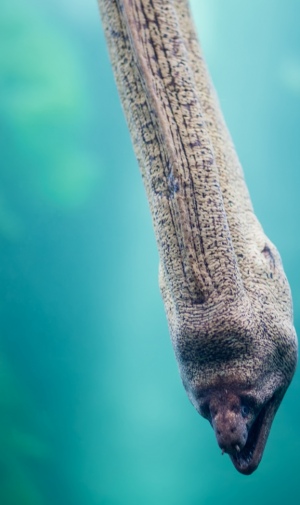You might not think that pelicans, bats and eels have much in common but they are all inspiring engineers to improve the performance of aircraft.
Visitors to the Summer Science Exhibition, an annual display at the Royal Society of some of the most exciting cutting-edge science and technology in the UK, can hear how Imperial College London scientists are using living organisms such as birds, fish and reptiles to find solutions to today’s engineering challenges.

Shimmering eel skin is inspiring aircraft design
Professor Jonathan Morrison and Dr Kevin Gouder are part of a team of 26 academics and students who will discuss how their latest designs are mimicking nature to improve aeroplanes’ performance and fuel efficiency, and minimise noise pollution.
Professor Jonathan Morrison, from the Department of Aeronautics, said: “Squeaky bats and slimey eels may not be everyone’s cup of tea but they are masters at manipulating their bodies to glide through their environment. Many aircraft components in existing planes have been inspired by animals and we are continuing to learn lessons from nature. We are making many exciting advances in the field of aircraft design, which will mean quieter, cleaner and greener planes in the sky in the future.”
The team, who are part of Flow Control Research Group at Imperial, will discuss how they are investigating how different animals have evolved to cope with friction caused between a surface, such as feathers or skin, and the fluid they are gliding through, such as air or water.
Working with their colleagues from IMFT and Laplace labs in Toulouse France, the team have been inspired by how eels are able to ripple their skin as they move through the water. By carrying out simulations and experiments, the team were able to show that small-scale skin motions used by the eel reduces the friction between the skin and the water flowing over it, which helps it to move more easily through water. The researchers have now mimicked this skin-ripple quality in a new membrane-like material, which could lead to improved aircraft performance, including better fuel efficiency.
The team will also discuss how they’ve gone batty over flying mammals. They have been studying how muscles enable a bat to constantly change the stiffness in its wings to create “bumps” that modifies the air flowing over them in order to help to improve their flying capabilities. If an aircraft is flying along and it tips its nose up too far, the wings can lose contact with the air flowing over them, which can cause the plane to stall and fall out of the sky. The researchers are developing prototype wing designs that mimic the way bats tense parts of their wings to create bumps. This modifies airflow so that it always remains in contact with the plane’s wings. Their work could ultimately improve aircraft safety.
Pelicans are another inspiration for the team’s research and they will discuss how they are developing electrically-controlled “feathers”, which are made from a new generation of plastics. These could reduce drag, noise and fuel consumption to make planes more efficient.
Dr Gouder added: “Aeronautics is at the forefront of addressing many of the challenges that the world is facing. The Royal Society’s Summer Science Exhibition provides us with another wonderful opportunity to talk to people about the exciting advances we are making in a range of fields including aircraft design. We really hope to engage with families and especially younger visitors to inspire them to get involved in engineering and aeronautics. We are excited to be sharing some of our group’s latest advances and we are looking forward to meeting the visitors.”
Ask a question about this exhibit in a live Twitter chat on Friday 4 July 12:00-12:45 by tweeting @aeflowcontrol using the hashtag #asksummerscience.
Article text (excluding photos or graphics) © Imperial College London.
Photos and graphics subject to third party copyright used with permission or © Imperial College London.
Reporter
Colin Smith
Communications and Public Affairs

Contact details
Email: press.office@imperial.ac.uk
Show all stories by this author




Leave a comment
Your comment may be published, displaying your name as you provide it, unless you request otherwise. Your contact details will never be published.